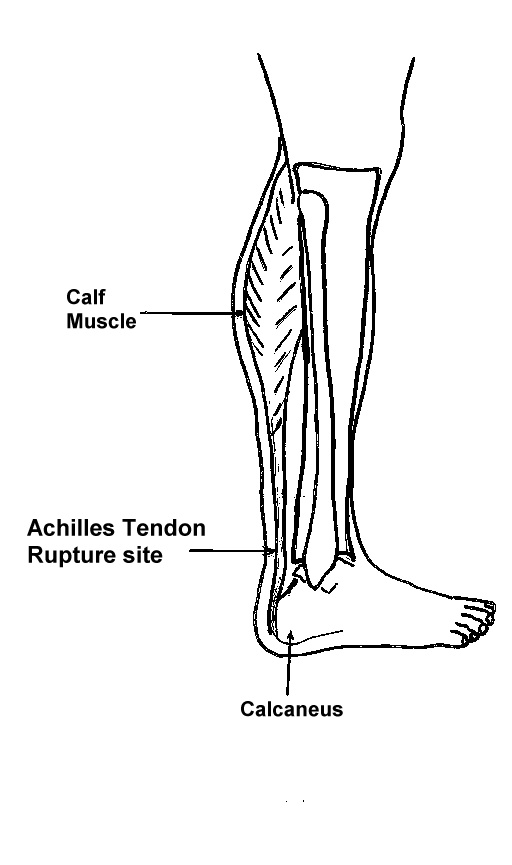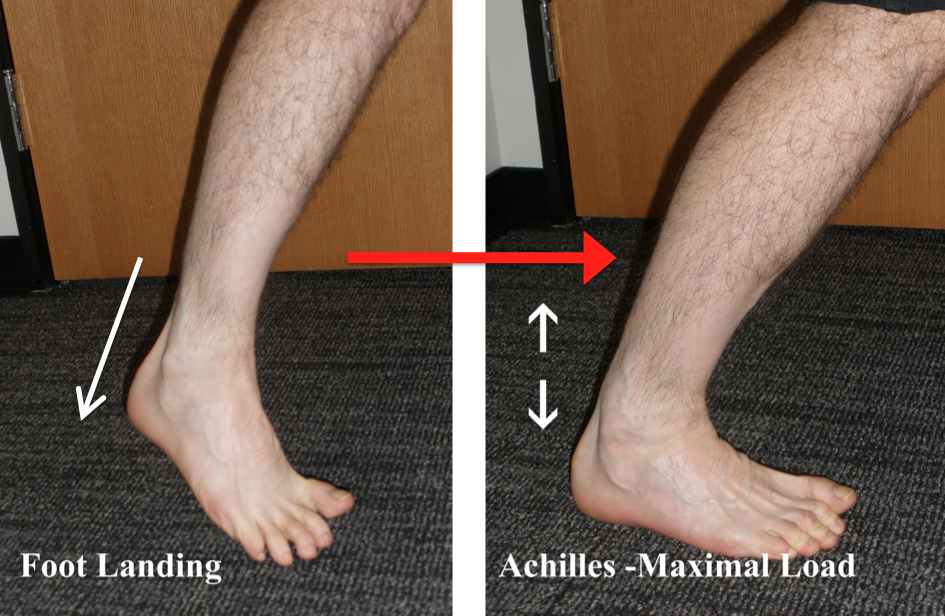There have been some high profile Achilles tendon ruptures recently, including NFL quarterbacks Aaron Rodgers and Kirk Cousins both suffering season ending Achilles tears. This has focused a spotlight on this fairly common injury. There are three important things to know about Achilles ruptures that will allow you to understand the injury –and why treatment of Achilles tendon ruptures can be challenging and prolonged:
- What is the role of the Achilles tendon in movement, particularly sporting movements?
- What do the Achilles tendon and the calf muscle need in order to function optimally?
- What are the inherent challenges associated with recovery from an Achilles tendon rupture?
Role of the Achilles Tendon
The calf muscle runs into the Achilles tendon (Figure 1). The tendon then attaches to the back of the heel bone. Effective functioning of this muscle-tendon unit is important for propelling the body forward, whether it be walking, running, or jumping to dunk basketball. When the calf muscle contracts it pulls through the Achilles tendon applying force on the heel bone which can move the foot downwards (plantar flexion). The calf muscle working through the Achilles tendon allows the foot to generate a strong push-off. However, “pushing off” is actually NOT the primary function of the calf muscle and the Achilles tendon. Its main function is to slow the upward movement of the foot immediately prior to pushing off (Figure 2). Think about suddenly changing direction like a running back might do in football. The calf muscle working through the Achilles tendon needs to generate a lot of force to limit, and then stop, the upward motion of the foot. This resistance to upward motion of the foot is essential so that the foot stops moving upwards and then begin the push-off motion -allowing the athlete to change direction. It is almost like a rubber band in that the Achilles lengthens with increased loading, and then recoils during push-off. This concept is critical to understand because it’s this phase when the calf muscle is contracting and the calf and Achilles are actually LENGTHENING when the most force goes through the Achilles tendon. This is known as an eccentric contraction. It’s during this phase just prior to push-off that the Achilles tendon ruptures.


Requirements for optimal Achilles function
To function optimally the Achilles tendon must be strong. Additionally, the calf muscle must not only be strong, but also contract in a coordinated manner. The forces generated by the previously mentioned eccentric contractions can be enormous –many times bodyweight in the case of certain athletic maneuvers. This is why the Achilles is the largest tendon in the body. It has to withstand the most force of any tendon. The need for the Achilles tendon and calf muscle to have optimal strength is problematic with respect to recovering from an Achilles tendon ruptures.
Inherent challenges in recovery from an Achilles tendon rupture
To function athletically we need a strong Achilles and a strong coordinated calf muscle. An Achilles tendon rupture affects both of these adversely for an extended period of time. A ruptured tendon will have no strength immediately after it has ruptured. It will remain weaker than needed for many months after the injury. This is because optimal tendon healing is a slow process. It takes time! Additionally, because the calf muscle is not used normally while the tendon is healing this muscle becomes considerably atrophied. This calf atrophy and loss of muscle coordination is exacerbated if the calf is not allowed to contract at all.
So the inherent challenge of recovering from an Achilles rupture is that not only does the tendon need to heal to the point where it can withstand maximal force (many times bodyweight weight), but the associated calf muscle ALSO needs to be strengthened. It invariably loses considerable strength and coordination during the extend time when the Achilles tendon is healing. This is why modern rehabilitation strategies for Achilles tendon recovery focus on keeping the calf muscle firing while still allowing the tendon to heal without stretching out. It is an inherent challenge. Even with a strong surgical repair it is often six months before the Achilles tendon has regained enough strength to think about beginning intense athletic activity. Unfortunately, during this extended recovery period the calf muscle invariably loses a marked amount of strength and coordination –even with an optimal rehab program. In addition to subpar athletic performance re-rupture of the Achilles is a distinct possibility. Re-rupture of the tendon can occur if an athlete returns to sports prior to regaining BOTH Achilles tendon strength, and calf strength and function.
Following an Achilles rupture the best outcomes occur when the patient and their medical team work diligently to balance allowing the Achilles tendon to heal strongly without lengthening, while still finding ways to fire the calf muscles so that calf atrophy is minimized -and then calf strength is ultimately regained. Good results can be achieved with both non-surgical and surgical repair. A strong surgical repair may allow patients to be using their calf muscle and Achilles a little earlier in the recovery process. However, this advantage needs to be balanced against the very real possibility of developing a devastating wound healing problem or infection. Working collaboratively with a skilled medical and rehabilitation team can greatly improve the chance of having a full recovery –although it won’t be quick!
Published December 29th, 2023